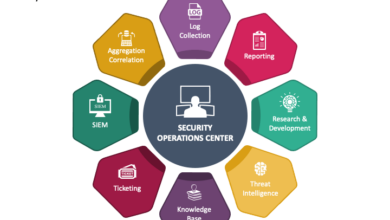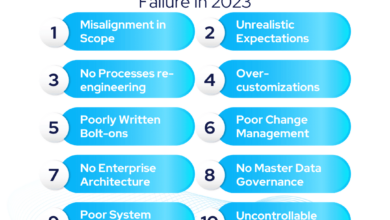
Rethinking the RFP Evaluating Commerce Platforms
Rethinking the rfp how to evaluate commerce platforms like an industry analyst – Rethinking the RFP: How to Evaluate Commerce Platforms Like an Industry Analyst sets the stage for a deep dive into the often-overlooked complexities of choosing the right e-commerce platform. Forget generic RFPs; this isn’t about ticking boxes. We’re talking strategic planning, forecasting future needs, and understanding the nuances of scalability, security, and seamless integration. This post will equip you with the knowledge to navigate the process like a seasoned pro, ensuring you choose a platform that truly empowers your business growth.
We’ll dissect the traditional RFP process, revealing its limitations and outlining a more effective, future-focused approach. We’ll explore critical features, from handling peak traffic to ensuring robust security, and delve into the crucial aspects of vendor selection and Total Cost of Ownership (TCO). Prepare to transform your RFP from a tedious checklist into a powerful tool for strategic decision-making.
Redefining the RFP Process for Commerce Platforms
The traditional Request for Proposal (RFP) process often falls short when evaluating complex commerce platforms. Rigid, checklist-driven approaches fail to capture the nuanced requirements and long-term strategic implications of such a significant investment. A modern approach necessitates a shift towards evaluating platform capabilities, scalability, and future-proofing, rather than simply ticking boxes on a pre-defined list. This requires a re-engineered RFP process that prioritizes open communication, iterative feedback, and a clear understanding of the vendor’s vision.A revised RFP template must go beyond basic feature lists.
It needs to thoroughly assess critical aspects that directly impact the success of the e-commerce business.
Revised RFP Template Sections
This revised template prioritizes evaluating vendors based on their ability to meet current and future needs. Sections focusing on scalability, security, and integration capabilities are crucial for long-term success. The template should also include sections for vendor references, pricing models, and service level agreements (SLAs). The emphasis is on understanding the vendor’s capabilities, not just their claims.
The template should be structured to elicit detailed responses and allow for comparative analysis. For example, the security section could include questions about data encryption methods, compliance certifications, and disaster recovery plans. The integration section should probe the platform’s APIs, its ability to integrate with existing systems, and the vendor’s support for custom integrations.
Traditional vs. Modern RFP Approaches
Traditional RFPs often focus on a rigid list of requirements, leading to a “check-the-box” mentality. This approach can stifle innovation and fail to uncover truly transformative solutions. Modern RFPs, in contrast, prioritize open dialogue and collaborative discovery. They focus on understanding the vendor’s capabilities, vision, and long-term roadmap. A modern approach would involve iterative discussions with vendors, allowing for a deeper understanding of their technology and how it aligns with the business’s strategic goals.
Instead of simply asking for features, the RFP should explore the vendor’s approach to solving business problems, their technological expertise, and their ability to adapt to changing market demands. For example, instead of asking “Does your platform support multi-currency transactions?”, a modern RFP would ask “Describe your platform’s architecture and how it scales to support growing international expansion, including multi-currency and localized payment processing.”
Comparative Analysis of RFP Methodologies
Three common RFP methodologies are: the traditional checklist approach, the weighted scoring model, and the request for information (RFI) followed by a request for proposal (RFP).
The traditional checklist approach, while simple to implement, often lacks the nuance to evaluate complex solutions. It focuses on binary yes/no answers and can overlook crucial qualitative aspects. Its weakness lies in its inability to capture the subtleties of vendor capabilities and the long-term implications of a platform choice.
The weighted scoring model assigns weights to different criteria, allowing for a more balanced evaluation. However, determining appropriate weights can be subjective and may not accurately reflect the relative importance of different factors. This method is more sophisticated than the checklist but still relies on predefined criteria, potentially limiting the discovery of unexpected, superior solutions. It can also be cumbersome to manage and score effectively.
The RFI/RFP two-stage approach allows for a more iterative process. The RFI gathers initial information, narrowing the field of vendors before a detailed RFP is issued to the shortlisted candidates. This approach provides a more focused and efficient evaluation process, enabling a deeper understanding of each vendor’s capabilities. This is arguably the strongest method, as it allows for a more thorough assessment and reduces wasted time on unsuitable vendors.
However, it requires more time and resources upfront.
Evaluating Key Platform Features
Choosing the right e-commerce platform is crucial for business success. A robust RFP (Request for Proposal) process is essential to ensure you select a platform that meets your current and future needs, especially when dealing with high-volume transactions. This section delves into the critical features to evaluate, focusing on functionality and scalability to withstand the pressures of a high-traffic environment.
We’ll examine both cloud-based and on-premise solutions, highlighting their strengths and weaknesses.
Essential Features for High-Volume E-commerce Platforms
A comprehensive RFP should include a detailed list of essential features, prioritizing those directly impacting performance under stress. These features should be rigorously tested by vendors to ensure they can handle expected and unexpected traffic spikes. Ignoring these aspects can lead to significant performance bottlenecks and lost revenue during peak seasons or unexpected surges in popularity. Below are some key considerations.
- Order Management System (OMS): The OMS should be highly efficient and scalable, capable of handling a large volume of orders simultaneously, including complex order processing scenarios (e.g., partial shipments, returns, subscriptions). Real-time order tracking and management capabilities are also vital.
- Inventory Management: Accurate, real-time inventory tracking across multiple warehouses or fulfillment centers is paramount. The system should integrate seamlessly with your existing inventory systems and provide robust reporting and analytics.
- Payment Gateway Integration: Seamless integration with multiple payment gateways is essential to provide customers with flexible payment options. The system should support various payment methods and ensure secure transaction processing, minimizing cart abandonment due to payment issues.
- Search and Navigation: A fast and efficient search and navigation system is critical for a positive user experience. The platform should provide robust search functionality, including auto-suggest, filters, and faceted navigation to help customers quickly find products.
- Catalog Management: Efficient tools for managing a large product catalog are necessary. The system should allow for easy addition, modification, and removal of products, including managing product variations, images, and descriptions.
- Scalability and Performance: This aspect is critical for high-volume e-commerce. The platform should be able to handle peak traffic without performance degradation, including features like load balancing, caching, and database optimization.
- Security: Robust security measures are essential to protect sensitive customer data and prevent fraud. This includes secure authentication, encryption, and compliance with relevant industry standards (e.g., PCI DSS).
Scalability Comparison: Cloud vs. On-Premise
The choice between a cloud-based and an on-premise commerce platform significantly impacts scalability. Cloud solutions generally offer greater flexibility and scalability, while on-premise solutions require more upfront investment and ongoing maintenance. The following table summarizes the key differences:
| Feature | Cloud Platform | On-Premise Platform | Comparative Analysis |
|---|---|---|---|
| Scalability | Highly scalable; easily adjust resources based on demand. | Scalability requires significant upfront investment and planning; upgrades can be complex and time-consuming. | Cloud offers superior scalability and flexibility, adapting to fluctuating demand with ease. On-premise requires proactive planning and substantial investment for future growth. |
| Cost | Pay-as-you-go model; costs are generally lower upfront but can increase with higher usage. | Higher upfront investment in hardware and software; ongoing maintenance costs. | Cloud offers potentially lower initial costs, but long-term expenses depend on usage. On-premise involves a higher initial investment but potentially lower long-term costs if usage remains relatively stable. |
| Maintenance | Vendor handles most maintenance and updates. | Requires dedicated IT staff for maintenance, updates, and security. | Cloud significantly reduces the burden of maintenance and updates. On-premise necessitates a dedicated IT team for ongoing management. |
| Flexibility | Easily integrate with other cloud services and applications. | Integration with other systems can be more complex and require custom development. | Cloud offers greater flexibility and ease of integration with other systems. On-premise integration often requires more effort and custom solutions. |
Evaluating Peak Traffic Handling
The platform’s ability to handle peak traffic and unexpected surges in demand is critical. Evaluating this involves several key criteria:
- Stress Testing: Vendors should conduct thorough stress tests simulating peak traffic loads to demonstrate the platform’s ability to maintain performance under pressure. The tests should cover various scenarios, including sudden traffic spikes and sustained high traffic.
- Performance Monitoring: The platform should provide robust performance monitoring tools to track key metrics such as response times, error rates, and resource utilization. This allows for proactive identification and resolution of performance bottlenecks.
- Disaster Recovery Planning: A comprehensive disaster recovery plan is crucial to ensure business continuity in case of unexpected outages or system failures. The plan should detail procedures for restoring service and minimizing downtime.
- Load Balancing: The platform should utilize load balancing techniques to distribute traffic across multiple servers, preventing any single server from becoming overloaded. This ensures consistent performance even during peak traffic.
- Caching Mechanisms: Effective caching strategies can significantly improve performance by reducing the load on the database and application servers. The platform should employ various caching mechanisms to optimize performance.
Security and Compliance Considerations
Choosing a commerce platform involves far more than just attractive features and a user-friendly interface. The security and compliance posture of the platform is paramount, especially when dealing with sensitive customer data like financial information, personal details, and purchasing history. A robust security framework is not just a nice-to-have; it’s a fundamental requirement for building trust with customers and avoiding potentially devastating breaches.Protecting sensitive data requires a multi-layered approach encompassing technical safeguards, operational procedures, and a strong commitment to compliance.
Failure to address these aspects thoroughly in your RFP can lead to significant financial and reputational damage down the line. This section focuses on identifying key security features and compliance standards to ensure your chosen platform adequately protects customer information and adheres to relevant regulations.
Data Encryption and Protection
Data encryption is crucial for safeguarding sensitive information both in transit and at rest. This means all data transmitted between the customer’s browser and the commerce platform, as well as data stored on the platform’s servers, should be encrypted using industry-standard algorithms like AES-256. The RFP should explicitly require details on the encryption methods used, key management practices, and the frequency of key rotation.
Furthermore, the platform provider should demonstrate a commitment to ongoing security updates and patching to address vulnerabilities in encryption algorithms or related software. For example, a platform boasting AES-256 encryption but failing to regularly update its security patches is vulnerable to known exploits.
Access Controls and Authorization
Robust access controls are vital to limit access to sensitive data based on the principle of least privilege. This means only authorized personnel should have access to specific data, and their access should be strictly limited to what’s necessary for their job functions. The RFP should detail the platform’s access control mechanisms, including role-based access control (RBAC), multi-factor authentication (MFA), and audit logging capabilities.
A comprehensive audit trail allows for tracking all data access attempts, helping to identify and investigate potential security incidents. For instance, the ability to track who accessed specific customer data and when is critical for identifying potential insider threats or data breaches.
Disaster Recovery and Business Continuity
Disaster recovery planning is essential to ensure business continuity in the event of unforeseen circumstances such as natural disasters, cyberattacks, or hardware failures. The RFP should explicitly request details on the platform’s disaster recovery plan, including data backups, recovery time objectives (RTOs), and recovery point objectives (RPOs). A well-defined plan should detail how quickly the platform can be restored to operational status after a disruption and how much data loss is acceptable.
For example, a platform boasting a RTO of less than four hours and an RPO of less than 24 hours demonstrates a strong commitment to business continuity. This should also cover geographic redundancy of data centers to mitigate the risk of single-point failures.
Security Question Checklist
The following checklist provides key security questions to include in your RFP:
- What encryption methods are used to protect data in transit and at rest?
- What key management practices are in place?
- How frequently are encryption keys rotated?
- What access control mechanisms are implemented (e.g., RBAC, MFA)?
- What audit logging capabilities are available?
- What is the platform’s disaster recovery plan, including RTOs and RPOs?
- What security certifications does the platform hold (e.g., ISO 27001, SOC 2)?
- What is the platform’s vulnerability management process?
- What incident response plan is in place?
- How does the platform handle data breaches and comply with relevant data protection regulations (e.g., GDPR, CCPA)?
Integration and Ecosystem Capabilities: Rethinking The Rfp How To Evaluate Commerce Platforms Like An Industry Analyst

Choosing a commerce platform isn’t just about the features it offers; it’s about how seamlessly it integrates with your existing technology stack. A robust integration strategy is crucial for efficiency, data consistency, and overall business success. Ignoring this aspect can lead to costly rework, data silos, and frustrated employees. This section will guide you through assessing a platform’s integration prowess.
The ability of a commerce platform to integrate with your existing systems, such as CRM, ERP, and payment gateways, is paramount. A smooth integration process minimizes manual data entry, reduces errors, and streamlines workflows. This directly impacts operational efficiency and allows for a more unified view of your customer and business data. A lack of robust integration capabilities can create significant bottlenecks and hinder growth.
API Documentation Assessment
Comprehensive and well-maintained API documentation is a cornerstone of successful integration. Thorough documentation allows developers to understand the platform’s capabilities, available endpoints, data structures, and authentication methods. Look for clear, concise explanations, examples, and readily available SDKs (Software Development Kits) in various programming languages. Poorly documented APIs lead to development delays, increased costs, and integration challenges. The quality of the API documentation directly reflects the platform provider’s commitment to developer support and integration success.
A well-structured API with clear documentation significantly reduces integration time and costs.
Integration Methods and Suitability
Various methods exist for integrating commerce platforms with other systems. The optimal choice depends on factors such as technical expertise, complexity of data exchange, and real-time requirements.
- APIs (Application Programming Interfaces): APIs offer a flexible and standardized way to exchange data between systems. RESTful APIs are commonly used for their simplicity and scalability. They allow for granular control over data exchange and are suitable for complex integrations requiring real-time data synchronization. For example, a clothing retailer might use an API to sync inventory levels between their e-commerce platform and their warehouse management system (WMS).
- Connectors: Pre-built connectors provide a simpler integration path for common systems. These often require less custom development but may offer less flexibility compared to APIs. For instance, a connector might exist to seamlessly integrate a platform with popular CRM systems like Salesforce or HubSpot. This simplifies the integration process for businesses already using these systems.
- ETL (Extract, Transform, Load) Processes: For less time-sensitive data synchronization, ETL processes can be used. Data is extracted from the source system, transformed to match the target system’s format, and then loaded into the destination. This approach is often used for batch processing of large datasets, such as migrating historical customer data from a legacy system to a new commerce platform.
A company migrating from an older e-commerce system might use an ETL process to transfer historical order and customer data to the new platform.
Vendor Evaluation and Selection
Choosing the right commerce platform is a critical decision, and a robust vendor evaluation process is paramount to success. This stage involves more than just comparing features; it requires a thorough assessment of the vendor’s capabilities, financial health, and long-term viability to ensure a successful partnership. This process will significantly impact your ROI and the overall success of your e-commerce strategy.Selecting the optimal platform provider necessitates a structured approach that goes beyond simply reviewing feature lists.
A comprehensive evaluation should consider several key factors, ranging from the vendor’s experience and financial stability to their support capabilities and overall commitment to customer success. Ignoring any of these elements can lead to significant challenges down the line.
Designing a Scoring System for Vendor Proposals
A well-defined scoring system is essential for objectively comparing vendor proposals. This system should weigh different factors based on their relative importance to your business needs. For example, security might be weighted more heavily than a specific integration feature depending on your industry and risk tolerance. A sample scoring system might allocate points across categories such as: Experience (25%), Financial Stability (15%), Support Capabilities (20%), Platform Features (25%), and Implementation Timeline (15%).
Each category can then be further broken down into specific criteria, with each criterion receiving a score based on the vendor’s response in their proposal. For example, under “Experience,” you might assess the number of successful implementations, years in business, and industry-specific expertise. This structured approach ensures a fair and consistent evaluation of all vendors.
Comparing Vendor Selection Methodologies
Several methodologies exist for vendor selection, each with its strengths and weaknesses. A common approach is the weighted scoring method described above, offering a quantifiable and transparent process. Another approach involves a multi-criteria decision analysis (MCDA) which allows for a more nuanced evaluation of qualitative factors, like cultural fit. A Request for Proposal (RFP) process often incorporates elements of both, combining a weighted scoring system with qualitative assessments from interviews and reference checks.
The most effective methodology depends on the complexity of the project, the number of vendors, and the organization’s decision-making style. A smaller project might benefit from a simpler weighted scoring system, while a large, complex project may require a more sophisticated MCDA approach.
Conducting Thorough Due Diligence on Potential Vendors
Due diligence is crucial for mitigating risks and ensuring a successful long-term partnership. This involves a comprehensive review of the vendor’s track record, including past project successes and failures. Scrutinizing client references is essential, obtaining direct feedback on the vendor’s responsiveness, problem-solving skills, and overall performance. Financial stability checks are also critical, including reviews of financial statements and credit reports to ensure the vendor has the resources to support the project and provide ongoing support.
Investigating the vendor’s security practices and compliance certifications is equally important, especially for businesses handling sensitive customer data. A thorough due diligence process can uncover potential red flags early on, preventing costly mistakes and ensuring a more successful partnership.
Cost and Total Cost of Ownership (TCO) Analysis
Evaluating commerce platforms solely on initial pricing is a recipe for financial headaches down the line. A comprehensive Total Cost of Ownership (TCO) analysis is crucial for making informed decisions and avoiding unforeseen expenses. This involves examining all costs associated with the platform throughout its lifecycle, from implementation to eventual decommissioning.Understanding the true cost of a commerce platform requires a multifaceted approach.
It’s not just about the upfront license fees or subscription costs; it’s about factoring in all the hidden expenses that can significantly impact your bottom line. This includes implementation costs, ongoing maintenance, integration with existing systems, security updates, and potential future scalability needs. A robust TCO analysis provides a clearer picture, allowing for better budgeting and informed vendor selection.
TCO Framework for Commerce Platforms
A robust TCO framework should incorporate several key areas. First, carefully estimate the initial investment, encompassing software licensing fees, implementation services, and any necessary hardware upgrades. Next, project ongoing operational costs, including hosting fees, maintenance contracts, security updates, and staff training. Crucially, anticipate future scalability needs and the associated costs of expanding the platform to accommodate growth.
Finally, consider potential risks and their associated costs, such as security breaches or system downtime. By systematically analyzing these elements, you can build a realistic TCO model for each platform under consideration.
Negotiating Favorable Pricing and Contract Terms, Rethinking the rfp how to evaluate commerce platforms like an industry analyst
Effective negotiation is paramount in securing favorable pricing and contract terms. Begin by thoroughly researching market rates for similar platforms and services. This provides a solid baseline for your negotiations. Clearly articulate your business needs and priorities to the vendors, highlighting your willingness to commit to a long-term partnership if the terms are mutually beneficial. Don’t hesitate to explore alternative payment structures, such as tiered pricing or performance-based fees, to align costs with your business outcomes.
Remember, a well-prepared negotiation strategy, backed by solid market research, empowers you to secure the best possible deal. For example, negotiating a lower initial price in exchange for a longer contract term can be beneficial, provided it aligns with your long-term business plan.
Cost Components of Commerce Platform Implementation and Maintenance
The following table breaks down the various cost components associated with implementing and maintaining a commerce platform. These estimates are illustrative and will vary based on the specific platform, chosen features, and business requirements.
| Component | Description | Cost Estimate | Notes |
|---|---|---|---|
| Software Licensing/Subscription | Fees for using the commerce platform software. This can be a one-time purchase or a recurring subscription. | $10,000 – $100,000+ per year | Varies significantly based on platform features and number of users. |
| Implementation Services | Costs associated with setting up and configuring the platform, including consulting, customization, and data migration. | $20,000 – $100,000+ | Highly dependent on the complexity of the implementation. |
| Hosting and Infrastructure | Costs for hosting the platform, including server costs, bandwidth, and storage. | $5,000 – $50,000+ per year | Can vary greatly depending on traffic volume and required resources. |
| Maintenance and Support | Ongoing costs for maintenance, bug fixes, security updates, and technical support. | $5,000 – $30,000+ per year | Often included in a subscription or offered as a separate service. |
| Integrations | Costs for integrating the platform with other systems, such as ERP, CRM, and marketing automation tools. | $5,000 – $50,000+ per integration | Complexity and customization requirements greatly impact costs. |
| Security and Compliance | Costs associated with ensuring the platform meets security and compliance requirements, such as PCI DSS for payment processing. | $2,000 – $20,000+ per year | Ongoing costs for security audits, penetration testing, and compliance certifications. |
| Training | Costs for training employees on how to use the platform. | $1,000 – $10,000+ | Depends on the number of employees requiring training and the complexity of the platform. |
| Customization and Development | Costs for developing custom features or modifications to the platform. | Variable, depends on scope | Can range from minor adjustments to major custom development projects. |
Illustrative Examples of Successful Commerce Platform Implementations

Choosing the right commerce platform is a critical decision, impacting everything from sales and customer experience to operational efficiency and long-term growth. Learning from both successes and failures can significantly improve your chances of a smooth and profitable implementation. This section examines several case studies, offering valuable insights into best practices and pitfalls to avoid.
Case Study: Successful Implementation at a Large Retailer
A major national retailer, facing limitations with their legacy e-commerce system, decided to implement a cloud-based commerce platform from a leading vendor. Their primary challenges included migrating millions of product listings, integrating with existing ERP and CRM systems, and ensuring a seamless transition for their large customer base. The solutions employed included a phased rollout approach, focusing first on a subset of products and customer segments.
This allowed them to identify and resolve issues early on, minimizing disruption. Furthermore, they invested heavily in training for their internal teams and partnered with the vendor’s professional services group for expert support during the migration process. The result was a successful launch, with minimal downtime and a significant improvement in website performance and customer satisfaction. Key performance indicators (KPIs) showed a marked increase in conversion rates and a reduction in cart abandonment rates following the implementation.
The retailer also experienced improvements in operational efficiency, reducing order fulfillment times and improving inventory management.
Case Study: Failed Implementation at a Smaller E-commerce Business
A smaller online business, aiming for rapid growth, attempted to implement a highly customized, open-source commerce platform without sufficient internal expertise. Their challenges stemmed from underestimating the complexity of the platform, lacking the resources for proper customization and integration, and failing to adequately plan for ongoing maintenance and support. The result was a prolonged implementation process riddled with bugs, security vulnerabilities, and integration issues.
The website experienced frequent downtime, negatively impacting sales and customer trust. Ultimately, the project was deemed a failure, leading to significant financial losses and reputational damage. The primary lessons learned were the importance of thorough planning, realistic resource allocation, and selecting a platform that aligns with the company’s technical capabilities and long-term goals. They should have opted for a more robust, supported platform that required less customization, especially given their limited internal resources.
Fictional Case Study: Successful RFP Process at a Mid-Sized Company
A mid-sized company, “GreenThumb Gardens,” selling gardening supplies, initiated a rigorous RFP process to select a new commerce platform. Their team clearly defined their requirements, focusing on scalability, integration with their existing inventory management system, and robust mobile responsiveness. They carefully evaluated proposals from three shortlisted vendors, using a weighted scoring system that prioritized key features and capabilities.
GreenThumb Gardens conducted thorough due diligence, including reference checks and security audits, before making their final decision. They opted for a platform that offered a good balance of features, scalability, and cost-effectiveness, acknowledging that the total cost of ownership (TCO) needed to be considered beyond the initial licensing fees. The successful implementation resulted in improved sales, enhanced customer experience, and streamlined operations.
The company’s strategic approach, emphasis on thorough evaluation, and focus on long-term TCO resulted in a successful outcome. They also emphasized the importance of a strong vendor partnership throughout the implementation and beyond.
End of Discussion
Choosing the right e-commerce platform is a pivotal decision, impacting everything from customer experience to operational efficiency. By rethinking the RFP process and applying the insights shared here, you can confidently navigate the complexities of platform selection. Remember, it’s not just about finding a platform; it’s about finding a partner that aligns with your vision and empowers your long-term success.
So ditch the outdated methods and embrace a strategic approach – your future self will thank you!
Detailed FAQs
What are the biggest mistakes companies make when creating an RFP for commerce platforms?
Common mistakes include overly generic requirements, failing to define clear success metrics, neglecting security considerations, and not thoroughly vetting potential vendors.
How can I estimate the Total Cost of Ownership (TCO) accurately?
Accurate TCO estimation requires considering not only the initial investment but also ongoing costs like maintenance, updates, support, and potential future scalability needs. Involve your IT team and vendor for a realistic assessment.
What if my existing systems aren’t compatible with the chosen platform?
Thorough integration planning is crucial. Assess the platform’s API capabilities and consider the need for custom integrations or third-party connectors. Factor integration costs into your TCO.
How long should the RFP process take?
The timeline depends on the complexity of your needs and the number of vendors considered. A realistic timeframe might range from 2-4 months.





